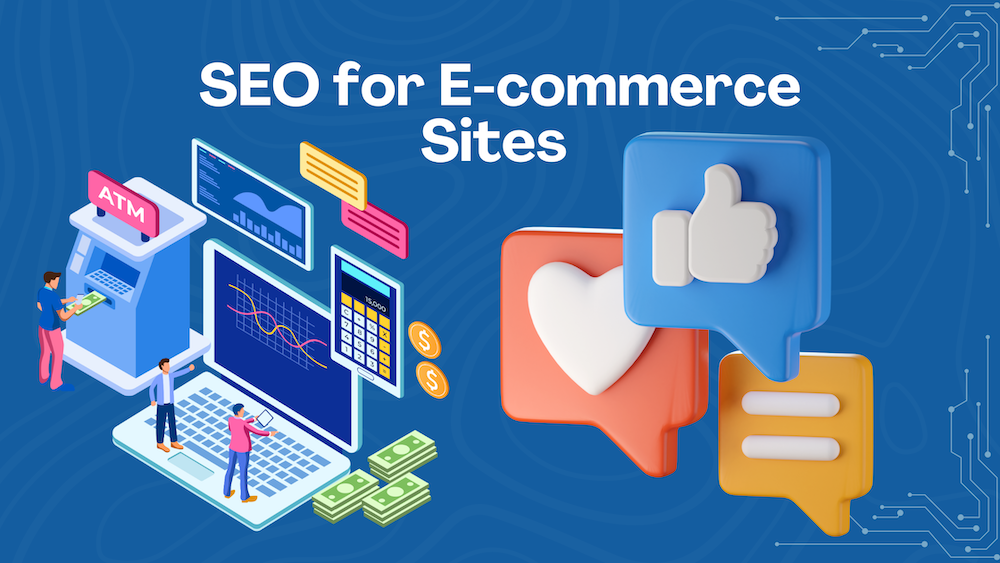In the competitive world of e-commerce, having a well-optimized website can make the difference between thriving and merely surviving. With search engines being a primary source of traffic, implementing effective SEO strategies is crucial for your online store's success. This blog post delves into the key aspects of SEO for e-commerce sites in 2024, providing actionable insights to enhance your site’s visibility and drive organic traffic.
-
Keyword Research: The Foundation of SEO
Keyword research remains the cornerstone of effective SEO. For e-commerce sites, it involves identifying the terms and phrases potential customers use when searching for products.
Steps for Effective Keyword Research:
- Brainstorm Seed Keywords: Start with broad keywords related to your products.
- Use Keyword Tools: Utilize tools like Google Keyword Planner, Ahrefs, or SEMrush to find relevant keywords.
- Analyze Competitors: Look at the keywords your competitors are ranking for.
- Focus on Long-Tail Keywords: Long-tail keywords, though less searched, often have higher conversion rates as they are more specific.
Example: Instead of targeting “shoes,” consider “women’s running shoes with arch support.”
-
On-Page Optimization: Enhancing Each Page
On-page SEO involves optimizing individual pages to rank higher and earn more relevant traffic.
Key Elements of On-Page Optimization:
- Title Tags: Ensure your title tags are compelling and include primary keywords.
- Meta Descriptions: Write clear and persuasive meta descriptions to improve click-through rates.
- Product Descriptions: Craft unique, detailed product descriptions with relevant keywords.
- URL Structure: Use clean, keyword-rich URLs.
- Internal Linking: Link to related products and categories to improve navigation and crawlability.
Example: Instead of a product URL like www.example.com/prod1234, use www.example.com/womens-running-shoes-arch-support.
-
Technical SEO: Building a Strong Framework
Technical SEO ensures that search engines can crawl and index your site efficiently.
Important Technical SEO Considerations:
- Site Speed: Optimize your site’s loading speed, as slow sites can hurt rankings and user experience.
- Mobile-Friendliness: Ensure your site is responsive and performs well on mobile devices.
- Secure Site (HTTPS): Use HTTPS to protect user data and boost trust.
- XML Sitemap: Create and submit an XML sitemap to help search engines understand your site structure.
- Canonical Tags: Use canonical tags to prevent duplicate content issues.
- Structured Data: Structured data is a standardized format for providing information about a page and classifying the page content. For eCommerce websites, structured data helps search engines understand the product details and enhances the visibility and appearance of the products in search results. The most common format for structured data is JSON-LD (JavaScript Object Notation for Linked Data).
Below mentioned elements of an eCommerce website can implement structured data using JSON-LD:
- Product
- Pricing
- Price Range
- Breadcrumb
- Site Navigation
- FAQ
- Organization
- Reviews & Ratings
- Local Business
- Videos
- Offers
Read more about ecommerce schemas and structured data on...
4. User Experience (UX): Prioritizing Your Customers
A great user experience not only retains customers but also positively impacts SEO.
UX Best Practices:
- Intuitive Navigation: Make it easy for users to find products.
- Clear CTAs: Use clear calls-to-action to guide users through the buying process.
- High-Quality Images: Use professional, optimized images to enhance product pages.
- Customer Reviews: Display customer reviews to build trust and provide fresh content.
-
Content Marketing: Beyond Product Pages
Content marketing can drive traffic and establish your e-commerce site as an authority in your niche.
Effective Content Strategies:
- Blog Posts: Write informative blog posts related to your products.
- Buying Guides: Create detailed buying guides to help customers make informed decisions.
- How-To Videos: Produce videos demonstrating how to use your products.
- User-Generated Content: Encourage customers to share their experiences and photos.
Example: A blog post titled “How to Choose the Best Running Shoes for Your Needs” could attract potential customers.
-
Link Building: Earning Authority
Backlinks from reputable sites can significantly boost your site’s authority and rankings.
Link Building Strategies:
- Guest Blogging: Write guest posts for authoritative sites in your industry.
- Influencer Partnerships: Collaborate with influencers to get your products featured.
- Press Releases: Announce new products or significant company news to gain media coverage.
- Broken Link Building: Find and replace broken links on other sites with your relevant content.
-
Local SEO: Attracting Nearby Customers
If you have a physical store or target local customers, local SEO is essential.
Local SEO Tips:
- Google My Business: Claim and optimize your Google My Business listing.
- Local Keywords: Include local keywords in your content and meta tags.
- NAP Consistency: Ensure your Name, Address, and Phone number are consistent across all platforms.
- Local Reviews: Encourage satisfied customers to leave reviews on Google and other local review sites.
-
Performance Tracking: Measuring Success
Regularly monitor your SEO performance to understand what’s working and what needs improvement.
Key Metrics to Track:
- Organic Traffic: Measure the number of visitors coming from search engines.
- Conversion Rates: Track how many visitors are converting into customers.
- Bounce Rate: Monitor the percentage of visitors who leave after viewing only one page.
- Keyword Rankings: Keep an eye on your rankings for target keywords.
- Backlink Profile: Analyze the quality and quantity of your backlinks.
Tools for Performance Tracking:
- Google Analytics: Provides insights into traffic, behavior, and conversions.
- Google Search Console: Monitors search performance and identifies issues.
- Ahrefs/SEMrush: Track keyword rankings, backlinks, and competitor analysis.
Last but not the least:
Automating meta tags for e-commerce sites is essential for maximizing efficiency and ensuring consistency across product pages. With hundreds or even thousands of products, manually creating meta titles and descriptions can be time-consuming and prone to errors. Automation not only saves time but also ensures that each product is optimized with relevant keywords, improving search engine visibility and driving organic traffic. Moreover, dynamic meta tag generation adapts to new product listings seamlessly, keeping your SEO efforts current and effective without the need for constant manual updates.
Automating meta tags for new products on an e-commerce site involves using dynamic content generation techniques, typically integrated within your content management system (CMS) or e-commerce platform. This can be achieved by creating a template-based system that leverages product-specific attributes stored in your database. Here’s a detailed, technical approach:
Step-by-Step Guide to Automating Meta Tags
- Template Creation:
- Meta Title Template: Define a template that dynamically generates meta titles. For example:
html
Copy code
<title>{{product.name}} - Buy {{product.category}} Online at {{store.name}}</title>
-
- Meta Description Template: Create a template for meta descriptions, incorporating key product features:
html
Copy code
<meta name="description" content="Shop {{product.name}} featuring {{product.feature1}}, {{product.feature2}}, and more at {{store.name}}. Enjoy great deals and fast shipping.">
- Database Integration:
- Ensure your product database includes fields for name, category, feature1, feature2, and any other relevant attributes.
- Example database schema:
sql
Copy code
CREATE TABLE products (
id INT PRIMARY KEY,
name VARCHAR(255),
category VARCHAR(255),
feature1 VARCHAR(255),
feature2 VARCHAR(255),
...
);
- Backend Scripting:
- Use server-side scripting (e.g., Python, PHP, Node.js) to fetch product details from the database and populate the meta tag templates.
- Example in Python with a Flask application:
python
Copy code
from flask import Flask, render_template
import sqlite3
app = Flask(__name__)
def get_product(product_id):
conn = sqlite3.connect('database.db')
cursor = conn.cursor()
cursor.execute("SELECT name, category, feature1, feature2 FROM products WHERE id=?", (product_id,))
product = cursor.fetchone()
conn.close()
return product
@app.route('/product/<int:product_id>')
def product_page(product_id):
product = get_product(product_id)
meta_title = f"{product[0]} - Buy {product[1]} Online at MyStore"
meta_description = f"Shop {product[0]} featuring {product[2]}, {product[3]}, and more at MyStore. Enjoy great deals and fast shipping."
return render_template('product.html', product=product, meta_title=meta_title, meta_description=meta_description)
if __name__ == '__main__':
app.run()
- Frontend Rendering:
- Ensure your HTML templates dynamically insert the generated meta tags.
- Example HTML template (product.html):
html
Copy code
<!DOCTYPE html>
<html lang="en">
<head>
<meta charset="UTF-8">
<meta name="viewport" content="width=device-width, initial-scale=1.0">
<title>{{ meta_title }}</title>
<meta name="description" content="{{ meta_description }}">
<!-- Other head elements -->
</head>
<body>
<!-- Product page content -->
</body>
</html>
- CMS Integration:
- If using a CMS like WordPress, WooCommerce, or Shopify, leverage plugins or custom code to automate meta tag generation.
- For example, in WooCommerce, you can use hooks and filters to modify meta tags:
php
Copy code
add_filter('wpseo_title', 'custom_product_meta_title');
function custom_product_meta_title($title) {
if (is_product()) {
global $product;
$title = $product->get_name() . ' - Buy ' . $product->get_category() . ' Online at ' . get_bloginfo('name');
}
return $title;
}
add_filter('wpseo_metadesc', 'custom_product_meta_description');
function custom_product_meta_description($description) {
if (is_product()) {
global $product;
$description = 'Shop ' . $product->get_name() . ' featuring ' . get_post_meta($product->get_id(), 'feature1', true) . ', ' . get_post_meta($product->get_id(), 'feature2', true) . ', and more at ' . get_bloginfo('name') . '. Enjoy great deals and fast shipping.';
}
return $description;
}
By implementing these steps, you can ensure that each new product added to your e-commerce site automatically includes optimized meta tags, enhancing your SEO efforts while saving time and maintaining consistency across your product listings.
SEO for e-commerce sites in 2024 is about more than just keywords; it’s a comprehensive approach that encompasses technical aspects, user experience, content marketing, and continuous performance tracking. By implementing these strategies, you can improve your online store’s visibility, attract more organic traffic, and ultimately drive sales. Stay updated with the latest SEO trends and continuously adapt your strategies to maintain a competitive edge in the ever-evolving digital landscape.
July 9, 2024





